Even eating becomes exhausting when you’re chronically ill – never mind preparing a meal. But you still need food to survive, and it can’t just be takeout. These energy-saving cooking tips are here to show you how you can still eat properly without needing to recuperate all your spoons just in time for your next meal!
If you have a chronic illness, you can save energy while cooking by planning meals in advance, doing grocery shopping online, cooking in bulk to freeze, cleaning as you go, splitting the responsibilities, having space to sit or rest, trying one-pot meals, changing your kitchen for your needs, using pre-cut or frozen produce, having the right prep tools and creating simple recipes.
But there’s a whole lot more where that came from. I’ve been trying to optimise my cooking strategy for the last 12 years. It’s not just about your everyday hacks – it’s about personalising them for chronic illness.
More...
So, if you want to know what it takes to eat well and still look after your wellbeing – then this article is going to help you figure out what will work best for you and how to go about it.
This includes:
- How to preserve your energy when you have guests;
- What to do when you need to eat but don’t even have the energy to make scrambled eggs; or
- Ways to cope when you’re in so much pain you can’t stand for more than two minutes at a time.
Plan Your Meals Once a Week – That's All You Need
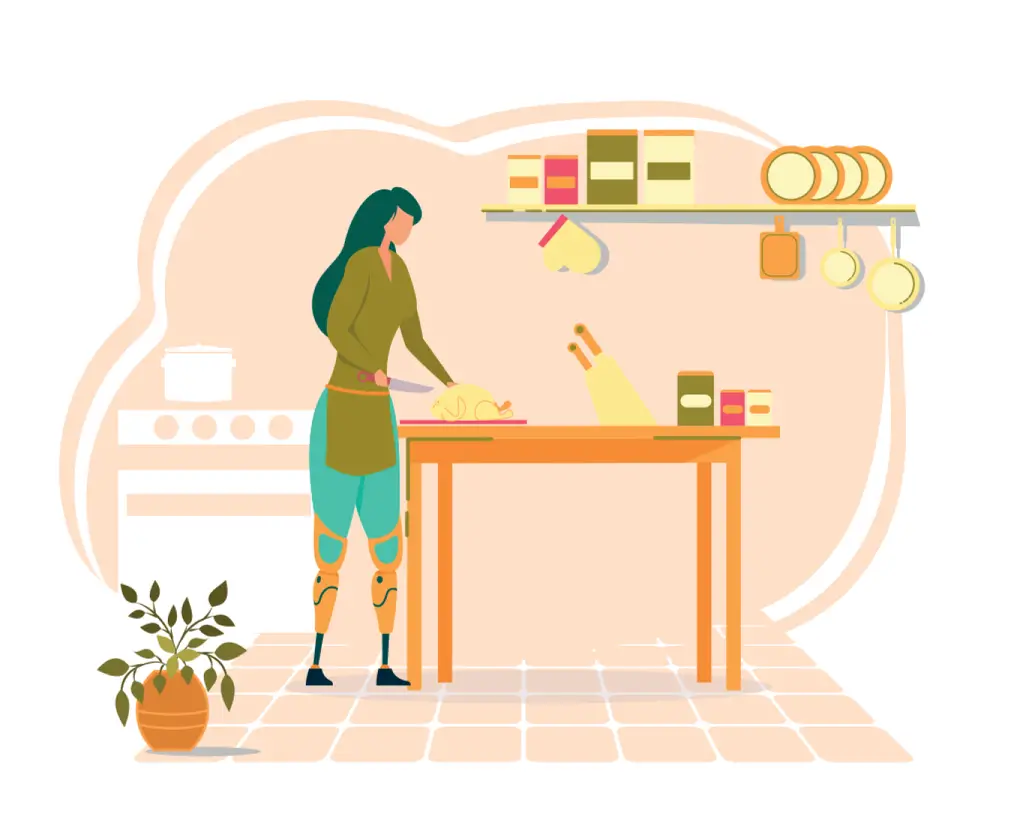
If you can plan a weekly menu – it’ll save you so much time, energy and thought that needs to go into cooking. It may take a little more mental energy initially – but I promise it’ll be worth it.
I know it may feel a bit overwhelming to plan your entire week's worth of meals – but there are a few ways to make it easier.
Find a few cookbooks that inspire you to make simple but good food
Don't buy more than five books. Keep things simple and specific. You're not here to look for fancy, lavish recipes – you want recipes that take basic ingredients and cooking processes to make new and interesting things.
This is always a great motivator to make a weekly meal plan and stick to it.
Whip out your diary and think carefully about your week ahead
One of the most demotivating things about weekly planners is that they often get thrown out of the window when your whole week “changes”. Make sure you plan your meals while you have your calendar out.
Think of birthdays, meetings, project deadlines – all of it. Use it to pre-empt what you’re realistically going to want to eat.
I know my life can get busy quite quickly. So I always plan about five dinners because I know I usually end up going out to eat about twice a week.
Be realistic about your energy levels
A meal plan really doesn’t have to be fancy. It’s there to help you minimise time spent in the grocery store and in the kitchen – while keeping some respect for your body by making healthy choices!
If you just want smashed avocado on toast for lunch every day – that’s okay!
Use a meal planning app to help you out
There are some really cool meal planning apps out there that make cooking from home feel so easy.
Especially since a lot of them are in partnership with major store chains and deliver your groceries to your doorstep, one app that I particularly like is eMeals. It gives you a two-week free trial period so you can test it out before you commit.
I love using apps, in general, to help me manage my chronic illness. If you want to do the same, here's my review on the latest chronic illness assistive apps out there: 13 Best Apps For People With a Chronic Illness
Use my free meal idea and shopping list guide
This is particularly designed for people with chronic illnesses who need to reserve their energy as much as possible.
I use basic mix-and-match recipes and coordinating shopping lists to make the whole meal planning process take less than 20 minutes.
Get your free recipe cheat-sheet and shopping list below:
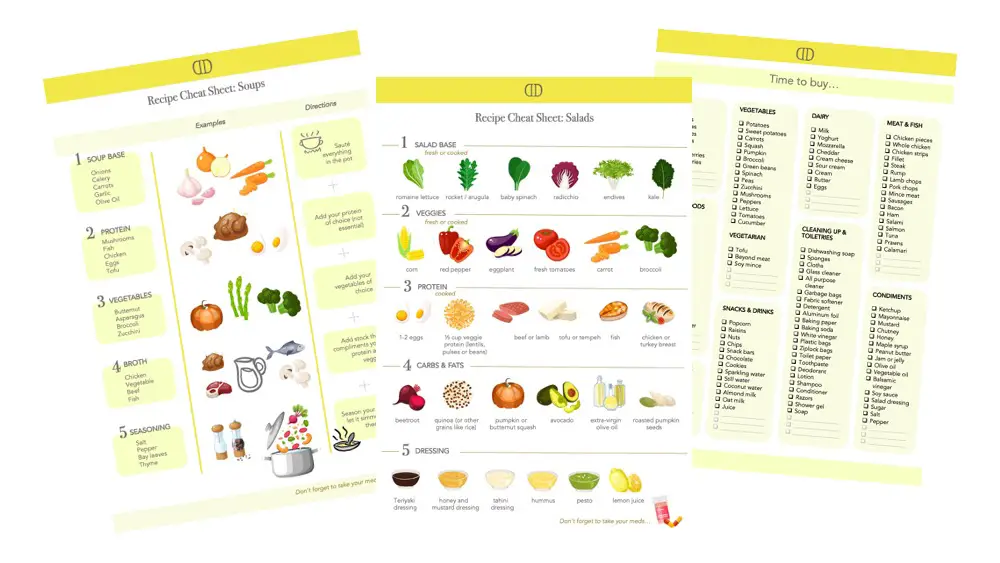
Save Energy and Do Your Grocery Shopping Online
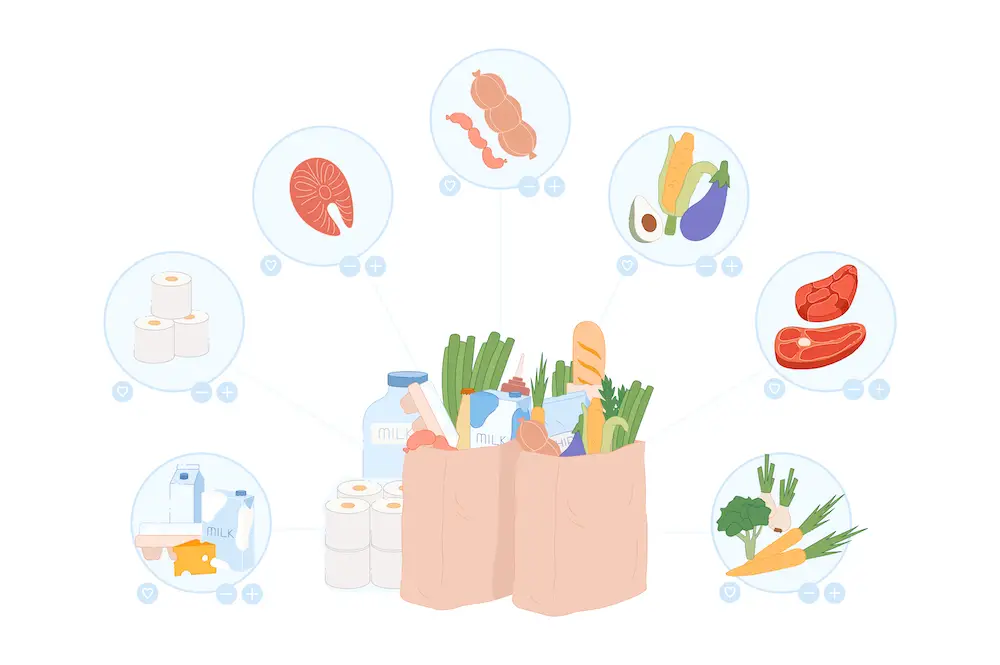
Technology is here for a reason, and we need to take full advantage of it.
One of the things that takes a crushing amount of energy as a spoonie is grocery shopping. From the transport, remembering everything you need, being on your feet for a long time and carrying heavy bags – it’s not ideal.
It’s not just about convenience to shop online when you have a chronic illness – it means you can preserve your energy (or spoons*) for more important things.
Another nice thing about online shopping is that you can automate routine purchases you need to make. This is particularly useful for pantry goods which are often heavy and tiring to carry.
If you can't do your shopping online – that's okay. Just make sure you plan ahead properly and choose one location where you can get everything you need.
Shop-hopping is exhausting, and it's not worth it if you can get everything you need in one place. Living in the city, or even an established town, means that this shouldn't be hard.
*Are you new to the spoon theory? This is something you need to know about. Here's a must-read article with really cool printable pages you can use: What is a Spoonie?
Make Sauces and Soups in Bulk (So Buy a Big Pot)
Coming from an Italian family, I learnt about cooking and freezing from a young age. This kind of meal prep has always been a useful hack, but I find it more beneficial now more than ever since I really need energy-saving cooking solutions.
Sauces and soups are the perfect foods to make in bulk, portion out and store in the deep freeze.
To give you an idea, here’s what I keep in mind at all times to feed a family of two (all homemade). These foods are perfect for days where you really don’t have the energy to cook and want something easy to clean afterwards.
And what's even better is that they're quite versatile and can accompany so many easy meals.
Butternut squash or pumpkin soup
Option 1: Serve with fresh cream and roasted butternut seeds (you can clean and roast these when you're making the soup and just store them in your pantry).
Option 2: Serve with cheesy toast.
Minestrone soup
Option 1: Serve with black beans and some chilli peppers.
Option 2: Serve with orzo or pasta.
Vegetable broth
Option 1: Simmer with chopped zucchini and corn and serve with toast.
Option 2: Simmer sweet potato, spinach and chilli peppers.
Bolognese sauce
Option 1: Toss into pasta with some parmesan cheese.
Option 2: Add to toasted bread, sprinkle with mozzarella and grill for 10 minutes.
Pesto sauce
Option 1: Toss into potato gnocchi with some parmesan cheese.
Option 2: Drizzle into grilled vegetables.
It takes 10 minutes to boil some pasta and no time at all to defrost the sauce – it's a winner when you want to eat quickly, wholesomely and not from a damn can!
Clean Up Your Mess As You Go Along

Half of the energy you dedicate to cooking needs to go into cleaning up afterwards. And one of the easiest ways to get around this is to clean as you go.
I talk about a lot in my article 5 Ways to Make Cleaning Easier When You Have a Chronic Illness.
Basically, if you can clean as you go, then you split the energy you have a little more evenly and don’t overdo it. If you cook your heart out and feel exhausted before you eat – dishes will be an energy-intensive task you keep putting off.
Another issue around cleaning is that if you have any chronic pain in your hands (as I do) – cleaning is really painful.
For ages, I hated doing dishes because of how the job hurt me. After I was diagnosed with Fibromyalgia and Raynaud’s (among other things), I realised that washing up wasn’t meant to be so sore.
My hands instantly swell and become stiff when I put them under either hot or cold water. And my dry skin starts to sting when I touch the soap – the whole process is just awful.
So, if you clean as you go, then you only need to wash one item at a time which is a lot less painful. And, of course, you can wear cleaning gloves to protect your skin and nails.
This brings me to my next point.
Split Your Cooking Responsibilities
It’s not always possible, I know. But if you do live with a partner, roommates or even friends – then see if you can’t assign kitchen responsibilities according to your strengths and limits.
For example, I thoroughly enjoy cooking, but I can’t be on my feet for long. Luckily, I can assign the cleaning to someone else.
Of course, there are other ways that you can spit kitchen jobs. Here’s what I recommend if you can’t hire help:
Alternate your daily responsibilities
This works well if you feel comfortable doing all the different kinds of kitchen work.
Play to your strengths
I recommend assigning responsibilities – not specific tasks. If you struggle with certain aspects of kitchen work, then be honest with your loved ones about it. It always takes a little compromise to assign roles, but it’s worth it.
Things like taking out the trash, putting groceries away or cleaning up are very labour intensive. But meal prep and cooking require more time and thought.
Use this as a basis to figure out your urgent needs and work around them.
Finally, add incentives to the work
Reward systems are always such good incentives for completing work that you don’t really want to do if your partner takes the brunt of the work when you can’t help out.
I find that organising their favourite snacks for a movie night or getting some fresh pastries for a Sunday morning always say “thank you” really well.
Of course, you can buy flowers or another non-food gift too. Given I’m Italian, food gifts are always appreciated.
Make Sure There is Space to Sit down and Rest
Part of what makes cooking so draining is that you need to be on your feet for quite a bit. And as much as I love making food, I have adjusted what I cook and how I prepare food to be less energy-intensive.
Besides keeping a chair nearby (just not by the stove while your food is cooking, please), here’s what you can do:
Avoid recipes that require your undivided attention
Things like risotto or cream-based sauces are notorious for being labour-intensive. Especially since they require a lot of stirring, you may want to save these foods for a night out.
Don’t have too many things cooking on the stove in one go
The more you are cooking, the more energy you need to put into multitasking and the longer you will need to stand over the stove – all of which is exhausting.
Make things in advance when guests come over
The stress that comes with entertaining can be very overwhelming. So, it’ll benefit you to prepare dishes that can be made earlier in the day and kept aside until it’s time to eat.
For example, if you want to make pasta, why not change it into a pasta bake instead?
You can make the sauce, combine it with the semi-cooked pasta beforehand, and keep it in the fridge until your guests arrive. Then you can pop it in the oven and forget about it until it’s ready.
When in Doubt – Use Parchment Paper
Parchment or baking paper must be one of my favourite kitchen items. And if you read my point on “clean as you go”, you’ll understand why.
It will save you the hour needed for soaking, scrubbing and cleaning
I love making roast dinners because you can chuck everything in the oven and leave it.
But if you lay some baking paper at the bottom of the trays – it will save you a lot of time and energy needed to clean up afterwards.
And it doesn’t stop there – you can use it to line your kitchen scale, bread bin or mixing bowls.
It’s potentially healthier for you
You have enough health issues as it is – so the more you look after your body, the better off you are. Using parchment paper can be a healthy alternative to drenching your food in oil before you cook it.
It works like a dream when you shop and cook to plan ahead
Parchment paper freezes so well. So, if you want to cut it up and use it to portion foods out or separate things like hamburger patties – you have a winner!
You don’t need to stress your joints out trying to ply frozen foods apart when it’s time to cook (and you avoid using plastic which is awesome).
A note on aluminium foil: Although it can be used as an alternative, you should know that a small amount of the heavy-metal gets ingested in the process.
For the average person, it shouldn’t be an issue. However, if you struggle with heavy-metal toxicity poisoning at all, you should avoid it. For the same reason, you would avoid canned foods, certain fish or even coffee capsules.
Learn to Love Wholesome One-Pot Meals
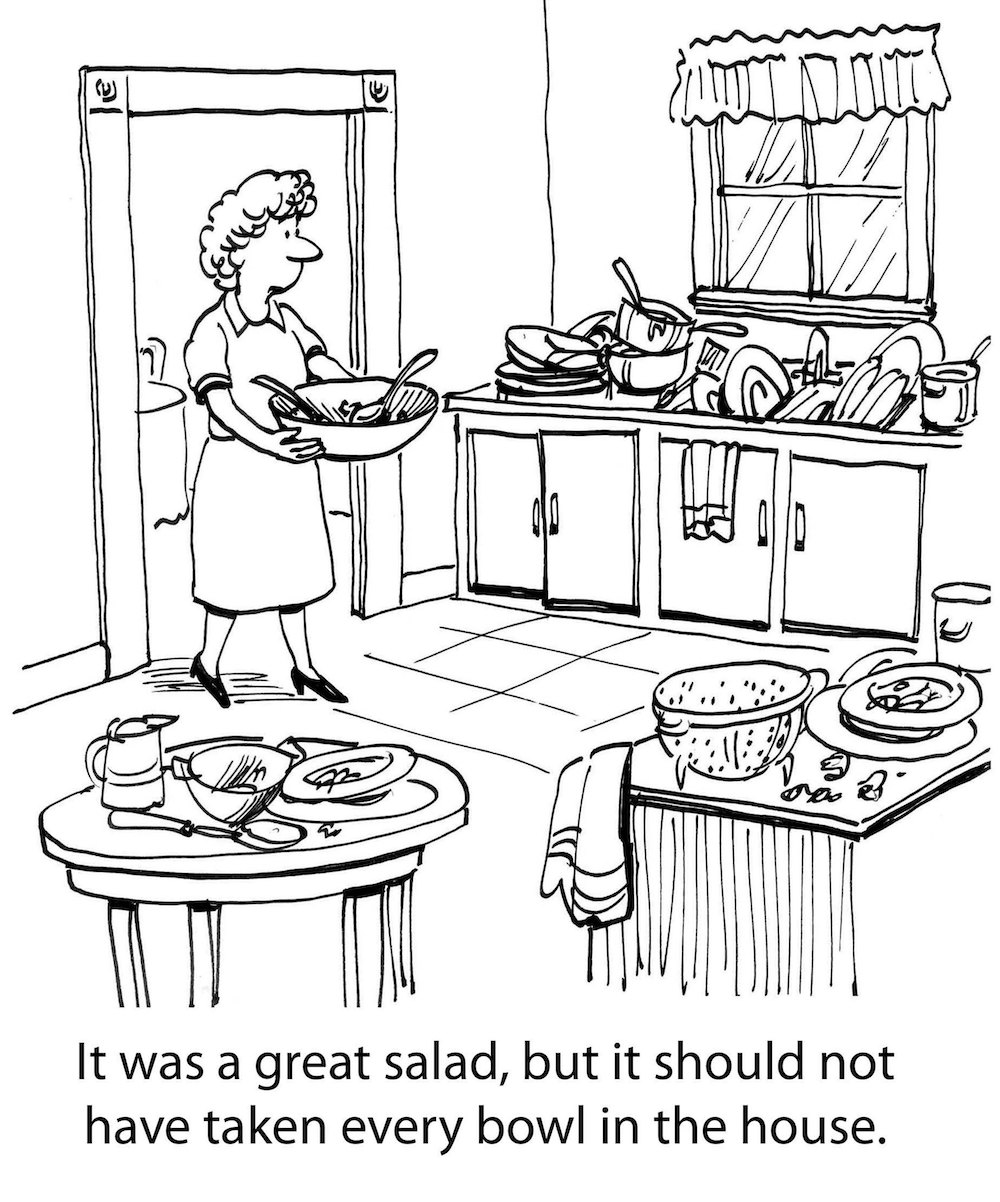
This is a great way to cook healthy meals when your energy levels are low, and you need a quick homemade option.
If you haven't spent hours scrolling on Pinterest – you'll probably be surprised at how vast and satisfying one-pot meals can be.
These don't have to be crockpot meals (but those do count) – it's really anything that you can make in one bowl, pan or dish.
One-pot meals are ideal if you have a chronic illness because they:
- Are simple to assemble;
- Don't have to take long at all to make (low-energy);
- Usually use flexible ingredients so you can alternate things depending on what you already have in your fridge (no extra shopping required);
- Only use ONE appliance if anything needs to be cooked;
- Are super easy to clean afterwards because you make very little mess;
At the end of this article, I share my favourite nine recipes for anyone with a chronic illness, and they're ALL one-pot meals. So keep reading to get those!
Buy Pre-cut or Frozen Fruit & Veg (Don't Be a Hero)
… or both!
There is absolutely nothing wrong with getting your fresh produce pre-cut. It shouldn’t make any difference at all to its nutritional value. However, it’s really important to ensure that it’s raw and fresh.
Pre-prepared foods don’t last as long, so make sure you check those expiry dates before you make a purchase.
Another great energy-saving tip is to buy certain foods freshly frozen. Again, it’s really important these aren’t pre-cooked meals. I’m talking about fresh fruit and veg here.
Not only does storing fresh produce in the freezer stop you from needing to rush out to the shops all the time – it may help you get more nutrients into your meals too.
This is because most frozen fruit and veg is picked at their peak and flash-frozen almost immediately – which helps preserve the integrity of the produce so well.
Of course, certain foods are healthier and taste better than others when they’re bought frozen.
Five of the best frozen foods that are easy to cook
Spinach, kale or other leafy greens
All dark green leafy vegetables freeze so well and are a pleasure to cook with even extends to herbs like parsley.
Evidence suggests that frozen spinach is more nutrient-dense than the fresh stuff – yay! You can even chuck the leaves into your smoothie mix – no fuss or nutrients lost.
Green peas
Yet another veggie that’s just as good frozen as the fresh option (and packed with protein). But the energy-saving benefit to frozen peas is that they take less time to cook and can be easily tossed into salads or soups.
Cauliflower and broccoli
I won’t lie – I prefer the fresh option from a taste standpoint, but the frozen options are still good. They just retain a little more water.
What I like to do is toss it straight into a roasting dish with olive oil, salt and a little parmesan cheese. Cook it at a high temperature until crispy.
Berries
Berries are a wonderful freezer staple – and often a lot cheaper to buy than the fresh variety. I have a small portion every day as part of my brain-boosting diet, and they’re super easy to prep.
You can chuck them straight into a smoothie, sprinkle over hot oats or defrost and serve with plain Greek yoghurt and raw honey.
Banana
You don’t necessarily need to buy banana frozen – you can chop it up and freeze it yourself in ziplock bags. This is especially useful when they’re about to get too mature, and you just don’t have the energy to make banana bread.
Once again, it’s a mess-free ingredient to add to a smoothie or even to make healthy ice cream.
Keep Easy-To-Use Pantry Basics
I learnt to love my pantry after I was diagnosed with a chronic illness. There are so many foods that can be stored for ages in your pantry that are nutrient-dense and easy to make meals from when you're chronically ill.
A well-stocked pantry will save you many exhausting shopping trips and potentially save you some cooking steps too.
Here's what I recommend keeping in your pantry at all times:
- Nuts and seeds
- Pre-soaked legumes (preferably jarred, not canned)
- Tuna (preferably jarred, not canned)
- Dried fruit, e.g. raisins, goji berries or fruit roll-ups
- Apple sauce or pieces
- Pickled foods, e.g. pickled gherkins, olives or artichokes
- Crackers and biscuits
- Grains, e.g. rice or quinoa
- Other hearty carbs bases, e.g. pasta, bread or couscous
- Nut butter of your choice – I like peanut and almond
Rearrange Your Kitchen to Suit YOUR Needs and Limits
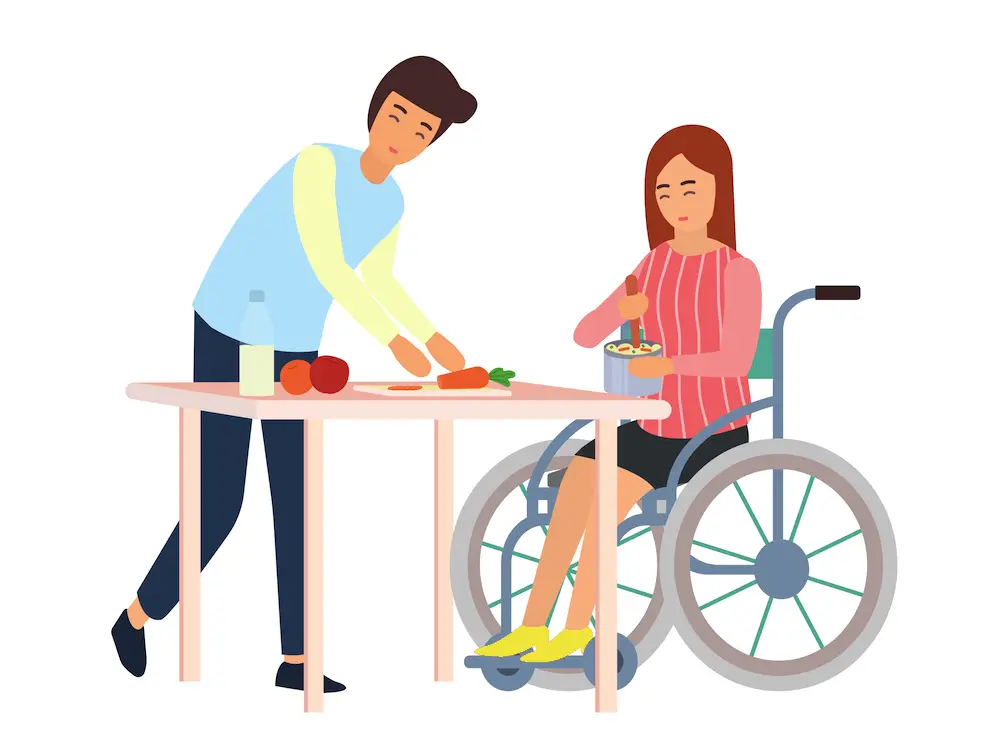
This was one of the things I struggled with after I was diagnosed and wheelchair-bound. I always loved cooking but being in a chair made it draining, and I gave up for a bit.
It took me a while to think about what a functional kitchen would mean for someone like me – and a lot of brainstorming – but it made enough of a difference to get me back in the kitchen.
Bottom line – it’s worth rearranging your kitchen according to your functionality needs for a few reasons.
- Helps you keep your utensil use and mess to a minimum.
- Stops you from using endless energy looking for things unnecessarily.
- Makes your cooking experience less stressful if what you need is easily accessible.
To make your life easier, I recommend shuffling your kitchen around into sections or zones according to what’s most important to you.
Section 1: Fridge and pantry items
E.g. Fresh produce, frozen goods, dry snacks, dry foods, spices
Section 2: Tea and coffee section
E.g. Kettle, coffee pot, tea selection, coffee and condiments
Section 3: Everyday eating
E.g. Crockery, cutlery, glasses, serving dishes
Section 4: Everyday cooking
E.g. Pots, pans, colander, cutting board, cooking utensils and measuring cups
Section 5: Kitchen storage
E.g. Parchment paper, tinfoil, Ziplock bags and Tupperware containers
Section 6: Cleaning stuff (that usually goes under the sink)
E.g. Sponges, cloths, soap and garbage bags
Section 7: Occasionally used items
E.g. Mixers, blenders, baking moulds, large serving trays for hosting and bar accessories
If you'd like to learn a little more about staying organised, especially if you have brain fog, I definitely recommend reading this article: 11 Tips For Staying Organised With Brain Fog
Get the Right Tools and Take The Strain Off Your Body
The kitchen tools you use can make cooking a pleasure – just as much as they can make it a pain. It all depends on what you have and how you choose to use each item.
For example, I’m a big advocate of using tools to make cooking easier, but not if they take longer to clean than to use. It defeats the whole purpose of an energy-saving device, if you ask me.
- A really good set of knives – there's nothing worse than fiddling with blunt knives if you suffer from any chronic pain in your hands. Regardless, trying to cut food with the wrong knife is tiring, and you risk hurting yourself more.
- Kitchen scissors – I like to label mine so that everyone knows they are meant to be in the kitchen and cannot be removed from the area.
- Standing blender (with smoothie attachment) – try and find a lightweight one that's easy to pick up and dismantle for cleaning purposes.
- Immersion blender – this is one of the most useful hand tools for making soups and sauces.
- Pressure cooker – this is an awesome appliance that helps speed your cooking process up, which is always great if you don't have time or energy to be in the kitchen for hours.
- Slow cooker – this is still a useful appliance as you can chuck your ingredients in and forget about it until dinner. So, even though it takes a while to cook, it doesn't require much effort or time.
- Cafe-style sandwich toaster – I love this machine because it's versatile, easy to use/clean, and it works so quickly. You can use it for sandwiches, wraps, burritos, or quesadillas – whatever you want.
- Hands-free can opener – I know it's a bit of a luxury, but if you have chronic pain, then I highly recommend it.
- Garlic twister – another great little device to have if you don't have any pre-cut garlic and need to work quickly with as little mess as possible.
- Fruit and veggie cutter – I like having this appliance on hand because it speeds up any cooking you need to do and makes it so much easier.
But more than that, it's a great little investment to make if you don't like spending extra on pre-prepped produce at the grocery store.
Use Social Media Time to Watch Cooking Videos
Leave Masterchef off for now – I'm talking about watching quick videos that food bloggers put up on Instagram, Pinterest or even TikTok (if that's your thing).
I recommend watching quick and easy recipe preparations because it gives you a really good visual idea of the best way to go around making any new dish you try.
There's little room for error or misinterpretation if you're following a video second by second.
So next time you spot an easy recipe, you need to do three things:
- Quickly check off the ingredients you need to buy on the cheat sheet I've given you.
- Save it so you can watch it later.
- Do your grocery shopping online once you've organised your meals for the week!
Try These Simple Energy-Saving Recipes
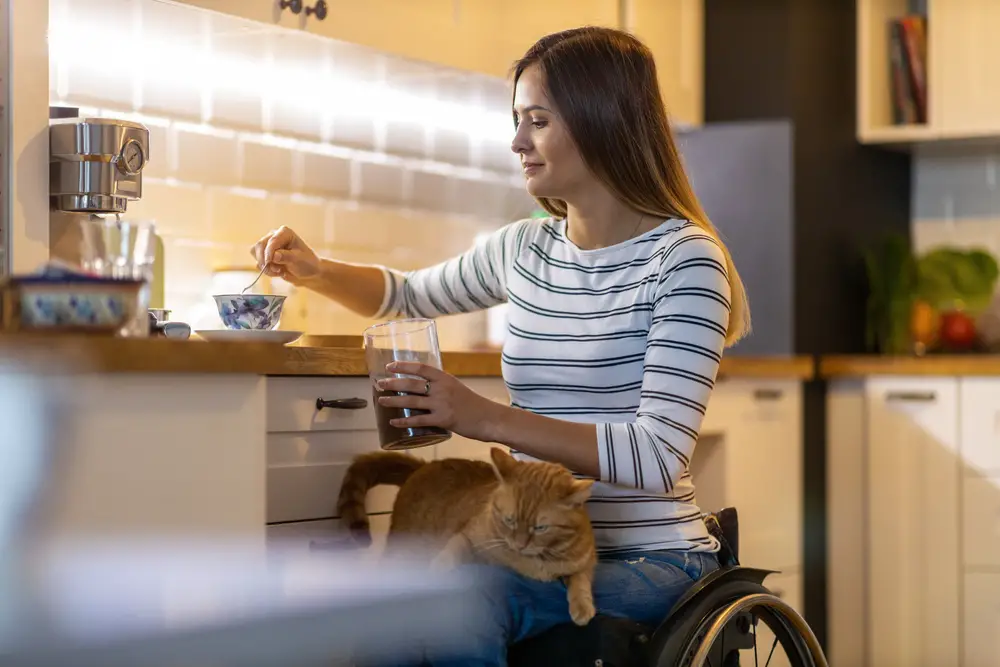
Cooking when you're chronically ill is all about making recipes simple.
If you're holding heavy appliances and scrubbing sticky pots – STOP.
I used to love cooking before I got sick, but I just can't afford to turn my kitchen into a creative storm of pots, pans and food on every counter.
Now, I need to forward-plan and make sure I'm putting together easy meals that leave me with enough energy to clean when I'm done.
Here are 9 of my favourite recipes that are ALL one-pot meals.
Three of my favourite energy-saving breakfasts
- Baked oatmeal cups (made four ways) Click here for the recipe
- Breakfast papaya bowl Click here for the recipe
- Spinach and mushroom frittata Click here for the recipe
Three of my favourite energy-saving lunches
- Moroccan chickpea and quinoa salad Click here for the recipe
- Avocado egg salad sandwich Click here for the recipe
- Ahi tuna bowl Click here for the recipe
Three of my favourite energy-saving dinners
- Golden coconut lentil soup Click here for the recipe
- Tender chicken and rice Click here for the recipe
- Crispy roasted gnocchi with garlic mushrooms Click here for the recipe
I hope these tips help you save some energy the next time you need to cook. And if you have any suggestions you'd like to share with me – I'd love to hear them.
Finally, would you like some video hacks on how to cook when you're chronically ill? Let me know, and we'll put it forward into consideration.

